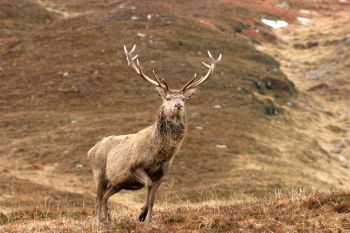
A red deer in the Alladale Wilderness Reserve, Scotland taken by Dr Chris Sandom.
New research suggests that wild herbivore numbers are not unnaturally high in the UK or the rest of the World despite what many conservationists believe, with data implying that, if anything, they are much lower than expected for healthy ecosystems.
A study co-authored by Dr Chris Sandom at the University of Sussex, suggests that at comparable levels of natural productivity there are typically less wild herbivores in Europe compared to Africa, where ecosystems are more intact.
The findings, published in the Journal of Applied Ecology, challenge the commonly held perception that the density of wild grazing and browsing species is 'too high' and causing damage to ecosystems.
Dr Sandom, Senior Lecturer in Biology at the University of Sussex, worked on the study led by Dr Camilla Fløjgaard and colleagues at Aarhus University, Denmark. He said: 'Diverse and abundant large herbivore communities like red, roe and fallow deer aren't the enemy of conservation or restoration, the problem is the degraded ecosystems humans are forcing them to live in.
'Our research shows that, naturally, densities of large herbivores are likely to be much higher than is commonly perceived. This, combined with the diverse and abundant communities of predators and vegetation, is what intact ecosystems should look like.
'The problems we're seeing, like the lack of tree regeneration, are likely because few remaining trees mean there is a limited seed source. Dense cover of grass, heather, and bracken mean there are few places for trees to germinate. The absence of large predators disrupting grazing and browsing pressure mean the few saplings that do establish don't stand a chance. This combination of factors needs to be kept in mind when we think about nature recovery. We can't just blame the herbivores."
The findings show that many nature reserves outside of Africa are depleted in large-herbivore biomass. According to the authors, nature restoration in these places needs to be focused on restoring functional ecosystems that include diverse and abundant wild large herbivores. This may include reducing herbivore numbers in the short-term, but could see spectacular and beneficial returns in the future.
"Even though large herbivores have been wandering the landscape for millions of years, it seems that we have become accustomed to landscapes almost completely devoid of them, and we have come to accept this as the natural state of things," says Camilla Fløjgaard, from the Department of Ecoscience at Aarhus University.
The study comes at a crucial time for the planet, with the commencement of COP26 in Glasgow and the UN's Decade of Ecosystem Restoration, which runs until 2030. The global initiative is described as 'a rallying cry' for the protection and revival of ecosystems around the world, for the benefit of both people and nature.
The authors of the study believe that, where we can strive for large-scale nature-recovery we should be aiming to rewild large herbivores and allow nature to manage their numbers without setting predefined targets.
Rasmus Ejrnæs, senior researcher from Aarhus University, said: "Bringing back big animals is crucial to restoring self-sustaining ecosystems and conserving biodiversity, but it is not going to be easy. Large animals are troublesome, because they damage crops, disrupt traffic and generally just get in the way. It will require political commitment and careful physical planning, including fenced reserves."
Dr Sandom said: "Herbivores are important because they help increase the diversity of nature as a whole by grazing and browsing, bark stripping and branch breaking, rooting and dunging, when they are in ecosystems that also include a mixed mosaic of vegetation types and large predators.
"In places, restoring nature may well involve reducing large herbivore numbers now, but this should be seen as an opportunity to restore the ecosystem to allow richer and more abundant nature across the board in the future, from plants to predators and including large herbivores.
"Ultimately, we need to see nature as a system and aim to restore all its component parts, and this includes wild large herbivores."






